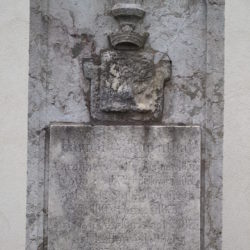
Coat of arms of the Pavich-Pfauenthal family in Kamnik
KAMNIK, ŽALE CEMETERY
Location of the coat of arms: tombstone
Next to the church in Kamnik’s central Žale Cemetery stands a tombstone with a mounted stone plaque revealing that it once belonged to the noble Pavich-Pfauenthal family. Above the plaque, the family coat of arms is carved on the tombstone, so ravaged by time that the heraldic elements are only recognizable to a knowledgeable eye. The coat of arms depicts a peacock holding a snake in its claws.
The Paviches were a Dalmatian family that already had a noble status in their old homeland. The first who established close ties with the Habsburg provinces was Anton Pavich (Croatianized: Pavić; 1740–1807), who served for forty years in the 4th Slunj Frontier Infantry Regiment. He fought in fifteen battles or military campaigns, sustained many wounds, and even found himself in war captivity. He retired in 1796 and the following year became the mayor of the military municipality of Zemun. In early 1799, Emperor Franz II rewarded him for his merit by elevating him to the rank of Austrian hereditary peerage. Associating his surname with the word peacock (Lat. pavo, Germ. der Pfau), Anton selected the name Pfauenthal for his predicate and had a peacock depicted as the central motif in his coat of arms.
His descendants forged even stronger ties to Slovenian territory, starting with his son Johann, who received in lease the Apfaltrers’ seigniories of Krupa and Pobrežje in White Carniola and found himself a wife from the said baronial family, Maria Ana Baroness von Apfaltrer. They married in Loka near Zidani Most, another estate owned by the Apfaltrers at the time. His older son Johann Jr. was the castellan of Radeljca Castle (Radelstein) in Lower Carniola and his younger son Karl was an official serving in Kamnik for a while. Kamnik is also where his family branch had its final resting place.
The Pavich family grave in Kamnik was built in 1857, after Karl’s wife Karolina, née Schmoll, died in Zagreb. Fulfilling her last wish, her remains were transferred to Kamnik and buried there. When Karl died in Graz seventeen years later (in 1874), his remains, too, were transferred to Kamnik to be buried in the same grave as his wife’s. However, winter (February) not being the most suitable time to enlarge the grave, Karl’s coffin was temporarily placed in the cemetery church. In early May, the deceased’s sons hired workers to rearrange and enlarge the family grave but were met with stark opposition from the local gravedigger, who claimed the exclusive right to dig graves. The dispute was finally resolved with the intervention of the Kamnik district commissioner, who authorized the hired diggers to carry on with their work. However, when they reached the mother’s coffin, they found it open, with a gilded cross having disappeared from the lid of the outer, copper coffin as well as all the deceased’s jewelry. In an uproar that followed, many villagers demanded to know whether their graves may have been vandalized as well. The work on the Pavich grave nevertheless resumed, the deceased was given a new coffin, and her husband’s coffin was placed into the extended grave. The gravedigger, the only suspect of grave vandalizing, was fired. The Pavich family decided not to bring the matter to the court: after so much time had transpired, it was practically impossible to establish the gravedigger’s guilt beyond doubt. In subsequent years, other family members were also buried in that grave: according to its plaque, it became the final resting place of five people.
The Pavich-Pfauenthal family attained the baronial title on the eve of the disintegration of the monarchy (in February 1918) and became extinct in its male line in 1959.
Sources:
Preinfalk, Miha: Plemiške rodbine na Slovenskem, 18. stoletje; 1. del: Od Andriolija do Zorna. Ljubljana: Viharnik, 2013, pp. 91-96.


